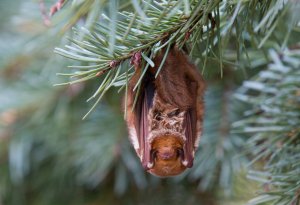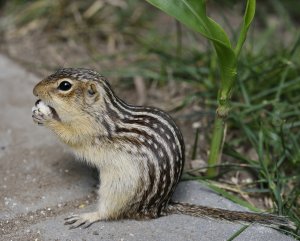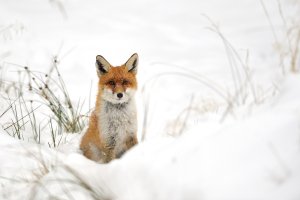Prepping for Winter: Mammals
November 15, 2023
By Steve Dishman, Interpreter
Brr! The nights are getting cold, it’s getting darker earlier, and most of us have already seen snow in the air. As autumn draws to a close, mammals are getting ready for winter. Mammals in Michigan can do one of three things to thrive in winter: migrate, hibernate, or adapt.

You may think that monarch butterflies and birds are the only animals to migrate to warmer climates, but so do some of Michigan’s bat species, such as the Red Bat and Silver-Haired Bat. Michigan’s migratory bats head to the American Southeast or Southwest to find their diet: insects. They will return to Michigan in the spring, where females will look to have their pups.
There are several types of hibernation. True hibernation is sleeping through the winter without waking to feed. The Thirteen-Lined Ground Squirrel is one of Michigan’s longest hibernators. They will eat a lot of food throughout the summer, so that they can begin hibernation as early as September! They will find a spot usually in the ground or sometimes a tree to slow their heart rate and sleep through the winter chill. Once asleep, they will not wake until the temperature rises. The Thirteen-Lined Squirrel males will usually emerge from hibernation before females. Michigan’s most famous hibernator is probably the groundhog or woodchuck.

Torpor is basically a light hibernation. These mammals are active much of the winter but may need to sleep to conserve energy. Another difference between mammals that utilize torpor versus hibernation is the amount they lower their body temperature. For hibernators, it’s sometimes over twenty degrees, but for mammals that torpor, it’s only a few degrees. If a mammal wants to rise from torpor, it will re-heat its body using fat cells, then wake up to forage. One of Michigan’s mammals that utilizes torpor is the Striped Skunk. In frigid, snowy weather, they will rest, but on warmer days, you may see a skunk looking for food later in the day.
There are plenty of mammals in Michigan that you may see throughout the winter. To survive and thrive in the winter, mammals will have to eat a lot. But with the changing seasons, some mammals have to change their diet. In Southeastern Michigan, White-Tailed Deer will move from eating grasses, nuts, and acorns to eating twigs, tree buds, and even the bark to survive. Deer, like cows, have a four-chambered stomach that gets the maximum amount of nutrients from these foods. Deer are often known to stop by bird feeders at nature centers too!
A final example of a remarkable mammal in winter is the Red Fox. They will grow a heavier coat as the temperatures cool. If you’re lucky to see a fox in winter, you will notice that they have a heavy coat like you do! Foxes also will hunt throughout the winter, even if they aren’t hungry. If successful, they cache their food in a spot and often bury it under the snow. In case they are unsuccessful in future hunts, they will return to dig up a past meal and consume it. It’s almost like eating leftovers from the freezer!

Michigan’s mammals are quite remarkable and with less tree cover, we often can see more deer, foxes, and coyotes in the winter. Just remember don’t disturb sleeping mammals and a fat mammal is a healthy mammal!
